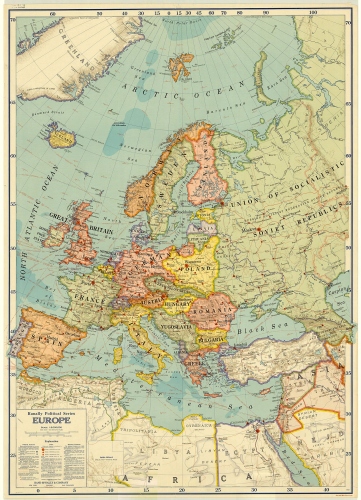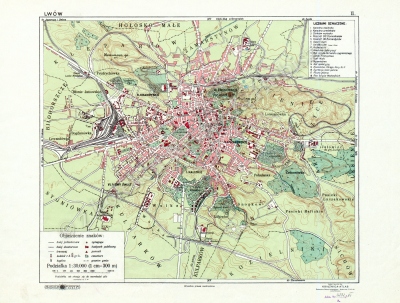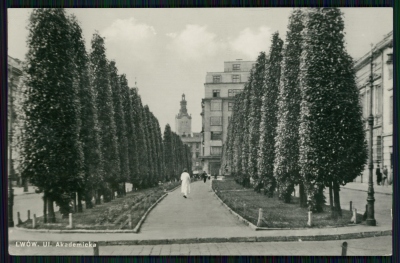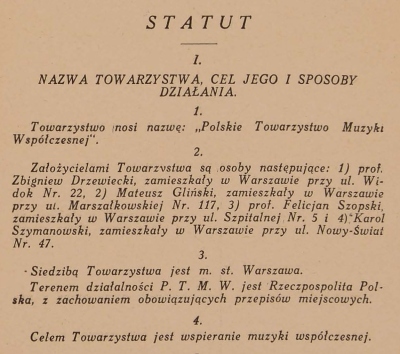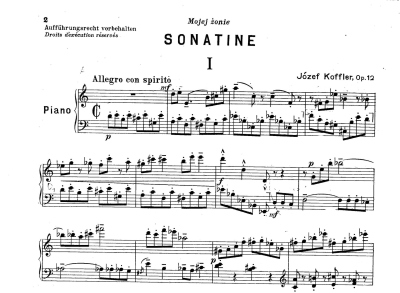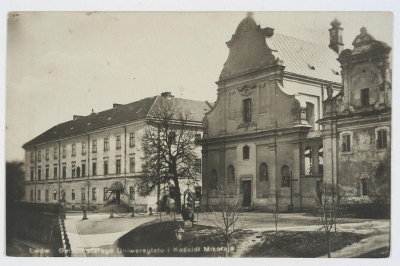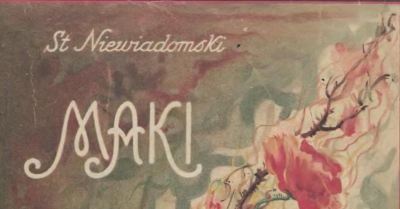
A Composer, Teacher and Journalist in Lwów (1924–1941)
Józef Koffler moved permanently to Poland in 1924. Initially he came back to Stryj, but soon he settled in Lwów, where he spent the crucial seventeen years of his life (1924–1941). Throughout that period, he resided in the city centre, near the Ossolineum, the Conservatoire of the Polish Music Society (Polskie Towarzystwo Muzyczne, PTM), and St Nicholas (University) Church. Initially (from 1925) he lived next to the Ossolineum and the Conservatoire at 4 Ossolińskich Street, from late 1929 or earlier – at 29 Mochnackiego Street near the University Library. Not later than in the spring of 1936, he moved with his wife to flat no. 2 in an elegant tenement house at 5 Piotra Chmielowskiego Street, just five hundred metres from the conservatoire, where the Kofflers with their newborn son continued to reside till December 1941 or later.
Koffler rarely travelled in Poland outside the Lwów Province in that period, but he regularly visited his hometown of Stryj, as well as Przemyśl (especially in 1930–1938) and the ‘Excelsior’ sanatorium in Iwonicz-Zdrój (1935, 1937). His possible trips to Kraków have not been confirmed. His only documented stay in Warsaw was in March 1932, when he served on the jury of the 1931 State Music Prize along with Karol Szymanowski, Stanisław Wiechowicz, Stanisław Niewiadomski, Jan Głowacki, Mateusz Gliński, and Tadeusz Joteyko. The jury held its deliberations at the Ministry of Religious Affairs and Public Education at 25 Szucha Street. The prize was awarded to Jan Maklakiewicz. Only his one work was performed in the Warsaw Philharmonic (1932, 1936).
Koffler nevertheless did travel abroad, mostly as part of his work at the International Society for Contemporary Music (ISCM). He visited Oxford (1931), Prague (1935, possibly also 1934), Vienna (1935), and London (1938). His stay in Amsterdam (1933) is not fully confirmed, but we may assume he was there for the festival performance of his 15 Variations, Op. 9a.
Lwów, the interwar Poland’s second largest academic and cultural hub after Warsaw, was Koffler’s main place of professional work. In 1931 Lwów was also Poland’s third largest city after Warsaw and Łódź. Though it ceased being the capital of Galicia after the fall of Austria-Hungary and only remained one of Poland’s sixteen provincial (voivodeship) capitals, it remained a major academic and cultural centre.
In 1931 Lwów had more than 312,000 inhabitants, 63.4% (more than 198,000) declared they spoke Polish at home. For 24.1% (more than 75,000) their mother tongue was Yiddish or Hebrew, for 11.2 % (more than 35,000) – Ukrainian or Ruthenian, for 0.78% - German. Most Poles were Roman Catholic, but Judaism was also a major religion in that city with 99,000 believers (1/4 of whom spoke Polish at home). Koffler was a member of that latter group until 1937. Apart from temporary crises related to World War I and the Great Crisis of 1929–1933, Lwów developed dynamically between the World Wars. Koffler’s modern music, using the latest techniques of that period, perfectly corresponded to the city’s development.
In 1929, Lwów's first modern office building (seven stories high), known as the New Sprecher Building and designed by Ferdinand Kassler, was erected on Akademicka Street near the Polish Music Society.
During the 1930s, amid intensified construction activity, numerous modern buildings were constructed for both residential and public use. Among the modern Polish architects working in Lwów during the functionalist period, alongside Kassler, were Marian Nikodemowicz, Zbigniew Wardzała, and Piotr Tarnawiecki.
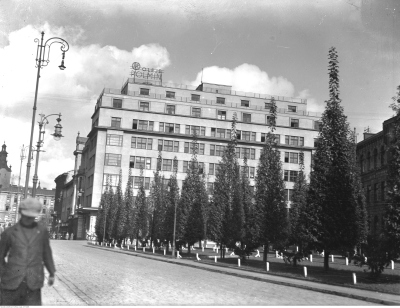






Between the school years of 1924/1925 and 1938/1939, Józef Koffler taught theoretical subjects at the Conservatoire of the Polish Music Society (PTM) at 7 Chorążczyzny Street. It was the oldest and largest such music school in southern Poland, with traditions dating back to 1853. Before Poland regained independence, it had operated as the Conservatoire of the Galician Music Society (GTM), and in the interbellum period – as the PTM Conservatoire. It was headed for many years by Mieczysław Sołtys (1899–1929), and later by Adam Sołtys (1929–1939).
In 1926, it employed forty-six teachers and had 926 students. Koffler took up the post of professor of harmony and atonal composition in 1928. It was the only such a specialised class of composition in Poland.
One of his outstanding pupils was Jakub Mund. Mund was a violinist, orchestra leader at Lwów Philharmonic and music director of the city’s municipal theatres. In 1934–1936 he led the Karol Szymanowski Lwów Music Conservatoire Student Orchestra, and in 1936 he made his debut as a conductor at Lwów Philharmonic. He was also quite successful as a music composer. Among others, his Chamber Symphony was nominated by the Polish jury for the ISCM festival in Paris. Koffler’s pupils also included the universally gifted Ryszard Apte, Roman Haubenstock-Ramati, Czesław Halski, and Zbigniew Szymonowicz (attending his classes in symphonic orchestration in 1940–1941).
Apart from teaching, Koffler dedicated his Lwów years to composing music, especially during his summer stays in Stryj. He was also active as a journalist and editor. Member of the International Society for Contemporary Music (ISCM) – the Lwów Brunch (established in 1930) of the Polish section, established in 1924 in Warsaw, he maintained direct contacts with that society's headquarters.
From 1925 or earlier, Józef Koffler maintained a close relationship with Róża Roth (b. 1904 in Żurawno in Galicia, now Zhuravno in Ukraine, living in Stryj). Koffler dedicated to her his arrangement of ‘Ty pójdziesz górą’ [You Take the High Road], one of his 40 Polish Folksongs for piano, a song originating among the nobility in the eighteenth century and commonly known in Polish cultural circles, also immortalised in literature (in Eliza Orzeszkowa’s novel On the Niemen).
Róża Roth graduated in French philology from Jan Kazimierz University in Lwów. Her friend Waleria Solecka describes her as a modest, shy and taciturn, but also beautiful and elegant woman. Koffler and Roth got married in the presence of rabbi Lewi Freund in the Lwów tenement at 31 Sykstuska Street in 1929; the witnesses were Leopold Muenzer and Józef Kurnak. In 1930, Koffler dedicated to his wife his Sonatina for piano, Op. 12 (1930).
Their only son was born on 3 August 1936. In November 1937 Józef Koffler withdrew from the Jewish community in Stryj. On 24 January 1938, forty-one-year-old Józef, his wife Róża, and son Jan Alban Reginald were baptised at Lwów’s St Nicholas (University) Church by Father Stanisław Narajewski, professor emeritus of the Jan Kazimierz University’s in Lwów Faculty of Theology and its former rector. The godparents came from the well-known southern Polish aristocratic Gołuchowski family: Wojciech (Adalbert, b. 1888 in Bucharest, d. 1960 in Warsaw, then senator for the Lwów province) and his wife Zofia née Baworowska (b. 1887 in Biskowice, now Biskovychi in Ukraine, d. 1971 in Warsaw).
According to Waleria Solecka, Józef Koffler maintained close contacts with a small number of people to whom he showed great dedication. Others he usually kept at a distance. His friends included pianist Leopold Münzer and the German conductor Hermann Scherchen, who conducted many of Koffler’s works, including Symphony No. 2, Op. 17 (its world premiere in Lwów 1937) and Symphony No. 3, Op. 21 (London 1938). Münzer, like Koffler, taught classes at PTM Conservatoire (piano in 1928–1939). Over the years he distinguished himself as the soloist who most frequently performed Koffler’s piano works. It was to him that Koffler dedicated his Concerto pour piano, Op. 13 (1932), most likely never performed in his lifetime. In December 1936, Józef and his wife Róża were guests at a reception held by Münzer in Lwów on the occasion of a visit by Béla Bartók.
Koffler also maintained (less close) contacts with the Austrian composer Alban Berg and Slav composers – active ISCM members such as Slavko Osterc and Alois Hába. With Arnold Schönberg he probably only corresponded. Koffler dedicated to him his 15 variations d’apres une suite de douze tons for piano, Op. 9 (1927) and wrote a Prelude and Fugue for orchestra for Schönberg’s sixtieth birthday (celebrated in 1934). Some momentarily closer contacts between Koffler and Karol Szymanowski seem to be indicated by the dedication of Musique. Quasi una sonata for piano, Op. 8 (1927).
Koffler may also have had some relations with Stanisław Niewiadomski (their only documented meeting took place in 1932 in Warsaw). Koffler arranged Niewiadomski’s songs (Piano Fantasia on the Theme of Niewiadomski’s Song written in 1927 or earlier). Before Koffler settled in Lwów, Niewiadomski had been a long-time lecturer at the then Conservatoire of the Galician Music Society (1887–1918) and head of that school’s branch in Vienna (1914–1918). Later (1919–1928) he taught at the State Music Conservatoire in Warsaw. In his arrangements of Niewiadomski’s songs from the Maki [Poppies] collection, Koffler drew on well-known Lwów cultural traditions.
As a musicologist, Koffler continued his contacts (initiated back in Vienna) with Seweryn Barbag, teacher at Lwów’s Music Institute (1923–1939, from 1931 – as the Karol Szymanowski Music Conservatoire). In Lwów, Koffler also occasionally contacted Adolf Chybiński, professor at Jan Kazimierz University (head of the Chair of Musicology in 1917–1939), whom he consulted on the form of his would-be Polish Suite in 1936.
Koffler also had contacts with other musicologists active in the Lwów branch of ISCM Polish Section (1930–1933), such as its chair Adam Sołtys, vice-chair Stefania Łobaczewska, honorary chairman Adolf Chybiński, and members, who included, apart from Koffler himself, also Zofia Lissa (secretary), Seweryn Barbag, and Leopold Münzer, among others. At PTM Conservatoire Koffler collaborated with many other teachers, including lawyer and musicologist Adam Mitscha (at PTM in 1926–1929), whom he also met in 1937 when they both took a cure at the ‘Excelsior’ sanatorium in Iwonicz-Zdrój. Mitscha remembered Koffler as a ‘cultured, intelligent and witty man’. On the latter’s career at PTM he commented: ‘Koffler was very enterprising and soon earned an adequate position (A. Mitscha, Zawiłe ścieżki, typescript). In Iwonicz-Zdrój they talked much about the twelve-note technique. After that sanatorium stay, Mitscha planned to take private lessons from Koffler (commuting from Katowice to Lwów), but this plan failed.
